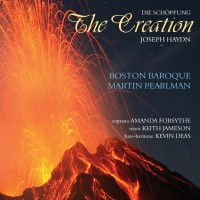Scardanelli’s April Motley
|
[The musical preferences of Signor Scardanelli, our Man in the Attic, resemble those of the editor. Force or cajolery play no part.] Signor Scardanelli [April 2013.] Mainers by preference, the editor and I have adopted a regionally appropriate fondness for the Red Sox, haddock and Martin Pearlman’s Boston Baroque, whose performance of Haydn’s Die Schöpfung (The Creation) is outstanding on several counts. As audiophiles, which, in terms of aesthetic prioritization, deposits us low on the Ascent to Discernment, we comment first, and unapologetically, on Five/Four Productions’ recording. The Creation is a big, exuberant work that, properly engineered, fills the listening room with voluminous riches – as many discs fail to do. How often we are reminded that recording persists as seven parts craft and three parts technology. And how pleasantly surprising that The Creation is an SACD, CD iterations of which are often off the mark. (Go, Pats!) Loud passages, well recorded, don’t “shout.” Rather, they embrace. This production’s deep-nap textures impart a lifelike quality to soloists, chorus and instrumentalists, all of whom impress us as first rate. Pearlman’s emphasis and pace translate, entirely appropriately, to a sense of ebullience and joy. Something we read in an earlier life positions Haydn and Mozart before and after Original Sin. Amen to that! The cast: soprano Amanda Forsythe, tenor Keith Jameson, bass-baritone Kevin Deas, the Boston Baroque’s instrumentalists and chorus, Martin Pearlman directing. Linn CKD 401. The notes to Fausto Romitelli’s CD, Anamorphosis (Tzadik Composer Series TZ 8087), contain a statement by the Italian composer (1963-2004), which includes: “At the center of my composing lies the idea of […] sound as a material into which one plunges in order to forge its physical and perceptive characteristics: grain, thickness, porosity, luminosity, density and elasticity. Hence it is a sculpture of sound […].” To say again, recording is a craft that, well done, fully reveals a work’s qualities – its sonic riches – as little else can. And this, good reader, is what perfectionist audio strives to achieve. The five brief chamber works – none longer than 11-plus minutes – introduce a composer new to us. Romitelli’s an original. We don’t hear clichés, let alone conventional rhetoric, nor do we hear the rock and techno he mentions as inspiration. Could be us. When we played Lachenmann’s Tanzsuite mit Deutschlandlied for a friend, he claimed to hear the hugely deconstructed German anthem we’ve never detected. As one might have guessed from the composer’s stated interests, the handsomely wrought music spans a broad range of atmospherics. Romitelli studied with Franco Donatoni, among others – an obviously fruitful association. The New-York-based Talea Ensemble, also new to us, perform these pieces with feeling and skill. Good sound, albeit a tad dry – a matter of taste. (Gianluca Lerici, who fashions himself Professor Bad Trip, did the insert and disc’s cheerfully outlandish art. Nice handle, prof.) A recently arrived Bridge CD (Bridge 9369, released in 2011) marks our Morton Feldman collection’s third recording of the composer’s Piano and String Quartet, composed two years before his death in 1987. A Nonesuch CD (9 79320-2), issued in 1993, features the players for whom Feldman wrote this masterpiece: Aki Takahashi and the Kronos Quartet. Another, hat[now]ART 128, with the Ives Ensemble (Amsterdam), appeared in 1991 as but one of hat’s stellar Feldman series – and our introduction to what has become an addiction. This 2011 Bridge, with pianist Vicki Ray and the Eclipse Quartet (Sarah Thornblade, Sara Parkins, violins; Alma Lisa Fernandez, viola; Maggie Parkins, cello), is a remarkably beautiful recording. The instrumentalists strike a perfect balance between ethereality and volupté, which the production’s technical aspect supports with commensurate sensitivity. The strings are as if suspended in space, and too, the piano – a rather more difficult illusion. The reading has the feel of a protracted love song. Peel away the avant-garde daring – the late music’s bare-bone, not quite repetitious, narrative-free excursions of extraordinary length – and we find a sensualist. No one has ever surpassed Feldman’s regard for his instruments’ sonorities. Congratulations and gratitude to producers Erika Duke-Kirkpatrick and Jess Gauthier, and recording engineer John Baffa. Feldman’s 1986 For Christian Wolff, for flute, piano and celesta (Dorothy Stone, flute; Vicki Ray, keyboards) is a much longer and rather more challenging work. The duo’s reading, along with the style of recording, as compared with Piano and String Quartet, and bearing in mind Feldman’s devotion to low-volume performances, plays – again, relatively – as four-square direct. Not that we’re complaining. Given the music’s extraordinary duration and absence of those seductive, organ-like strings, the interpretation strikes us as perfectly fitting. Close to three hours of applied atmospherics would have proven a bit much. Bridge 9279A/C, three CDs, released in 2008.
[More Signor Scardanelli]
[Previous Article:
Mostly Symphonies 21.]
[Next Article:
Michel Chion (EA Bucket 18.)]
|



